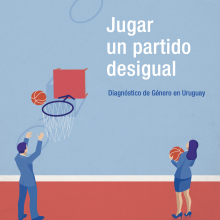#MujeresUruguay
This new campaign combines facts with the stories of different Uruguayan women, all of which share the same narrative: facing inequality and the labor market as women.
#MujeresUruguay aims at raising awareness of this issue in Uruguay and giving voice to these stories, which can be told by thousands of Uruguayan women.
New Report: Jugar un partido desigual [An Unfair Fight]
Data presented in the #MujeresUruguay campaign are part of “Jugar un partido desigual”, a report in which the World Bank diagnoses Uruguay’s current gender situation.
The study analyzes several sectors in which women face barriers or inequalities, such as quality of employment, economic opportunities, pay gap, aging, education, violence, decision-making and care work, among others.
The report aims at aiding conversation and reflection. The benefits of closing gender gaps aren’t exclusive to women. Neither is the responsibility.
Changing this reality requires us all to make an effort. The first step to closing these gaps is gaining access to reliable data on the issue:
